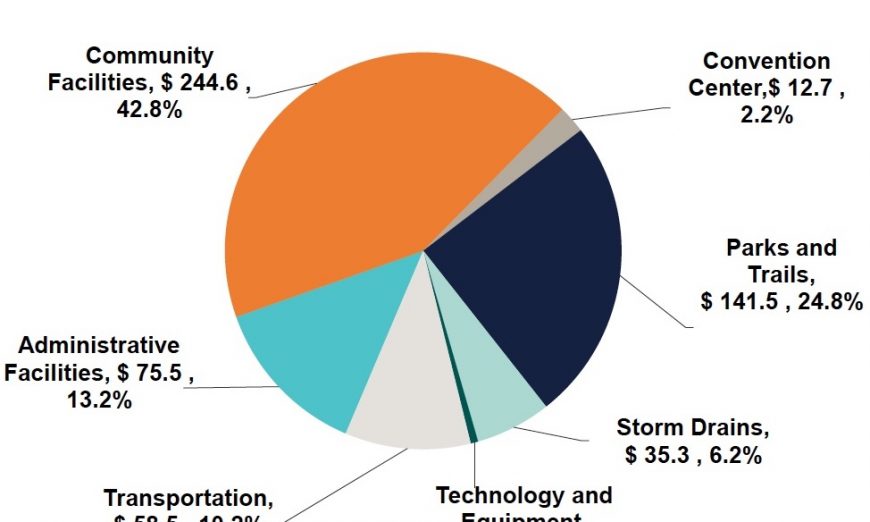Back in 2017, Santa Clara’s finance department forecast that by 2023 the City would face a cumulative shortfall of $600 million for meeting its plans for public investment in roads, city buildings, parks and recreation facilities. Only about $10 million of those needs are funded in the 2022/23 —2023/24 biennial budget.
Unlike many forecasts over the years, that one turned out to be spot on, with cumulative unfunded (general fund) projects reaching $572 million in the 2022-2023 five-year plan. What’s more, that number “does not fully represent all the unmet/deferred maintenance needs in the City beyond the 5-year CIP period,” says the budget book.
Santa Clara’s 2022/23 capital budget includes repairs to City and historic buildings, including the Morse Mansion; replacing concrete at the Central Park library; storm drain maintenance and repairs; replacing personal protective equipment; updating the City’s financial, utility and human resources management systems; replacing a seriously deteriorated parks center roof; and street, bridge and convention center maintenance and repair.
Santa Clara’s enterprises — such as Silicon Valley Power and water and sewer — finance capital projects primarily from business and residential charges for services. The City says that anticipated revenue and utility reserves will cover all the plans.
The capital improvement budget for these utilities includes building a new electrical substation at Kifer; replacing a transmission line that was severely damaged in the 2021 Dixie Fire; upgrading some transformers to meet load growth over the next 30 years; sewer repairs and replacement; and pump station and storm drain rehab.
The City will also begin design of Community North Park — which will be funded by a $5 million donation from Related Companies — and renovation of Westwood Oaks Park that includes new amenities and a new playground.
But the capital budget excludes much more than it includes.
As in 2017, the biggest shortfall in 2022-23 is in the budget for community facilities, mostly in the Parks and Recreation capital budget, which has $246 million of approved or anticipated projects, of which only $1.4 million — 0.6% is funded.
The CIP Reserves balance is currently $5 million and is funded by the general fund; revenues from state and federal infrastructure programs; state and county taxes and grants; service charges and fees; and bonds issued for specific projects. Only critical projects and those having to do with reliability and ongoing operations are included in the plan.
With an ongoing — structural — budget deficit and minimal general fund surpluses, there is no way Santa Clara can fill the gap without issuing a bond or drastic operating budget cuts, Finance Director Kenn Lee says.
“We would need new dedicated revenues for capital projects such as an Infrastructure Bond,” he told The Weekly. “Other cities also fund infrastructure through parcel taxes, real estate transfer taxes, storm fees and other special taxes. It would need to be from new sources or reductions in other areas of the existing budget. However, with our deficit, the priority will be to maintain as much of our current essential services within our existing budget first.”
This budget isn’t enough to maintain Santa Clara’s Pavement Condition Index (PCI)—a measure of the quality of street surfaces—at its current grade of 75 (out of 100). And the budget won’t return Santa Clara’s grade to what it was 15 years ago, 84, when Santa Clara received the Metropolitan Transit Commission’s “Best All-Around Pavement Management Program” award. Also among the unfunded projects are traffic improvements — including Great America intersection improvements — and curb ramp replacements for ADA compatibility.
In 2016, the City Council approved a plan for a new Central Park aquatic center complex, first proposed in 2014 and estimated at $200 million. But there is no funding and no prospect of any that would do more than develop a master plan, which will cost $2.4 million, of which only $358,000 is currently funded. Over the years, various schemes for financing this project with donations and private capital — “creative financing” — came to nothing. The plan is to finance this along with a Parks & Recreation master plan as development fees come in.
The City anticipates collecting $16.2 million in developer park fees in the coming year, but in 2021/22, Santa Clara received only $1.5 million. These fees are directly tied to new residential construction.
You can find Santa Clara’s 2022-23/2023-24 CIP budget at http://www.santaclaraca.gov/government/departments/finance.






